Phytochemical and Pharmacological Activities of Different Fractional Extracts of Firmiana Colorata R. Br. (Family: Malvaceae) Leaves
Tahmina Abeda1, Md. Jakir Hossain2, Suhana Manzur Chowdhury2, Sirajum Munira2, Mohammed Ibrahim2, Qamrul Ahsan2 and Md. Shahidul Islam1*
1Department of Pharmacy, University of Science and Technology Chittagong, Bangladesh
2Department of Pharmacy, Southern University, Bangladesh
Submission: January 13, 2020;Published:March 04, 2020
*Corresponding author:Shahidul Islam, Department of Pharmacy, University of Science & Technology Chittagong, Bangladesh
How to cite this article:Shahidul Islam, Tahmina Abeda, Jakir Hossain, Suhana Manzur Chowdhury, Sirajum Munira, et al. Phytochemical and Pharmacological Activities of Different Fractional Extracts of Firmiana Colorata R. Br. (Family: Malvaceae) Leaves. J of Pharmacol & Clin Res. 2020; 8(3): 555736. DOI:10.19080/JPCR.2019.08.555736
Abstract
Medicinal plants are rich sources of bioactive compounds and thus serve as important drug material for drug production. Most of the plant species are rich sources of medicines and therefore, the active principles responsible for their therapeutic actions have to be isolated and identified. This necessitates extensive phytochemical and pharmacological study of the plants. In the present study, the plant F. colorata which belongs to the family Malvaceae has been selected on the basis of its local uses by the traditional practitioners and also on the basis of related information from literature siltation. . Different fractions (Ethanol, n-Hexane and Chloroform) of the crude extract obtained from the leaves of F. colorata after cold and hot extractions were used in overall biological and pharmacological tests. Maximum clot lysis activity observed in clot treated with Streptokinase (SK) which was 89.38% extracts of F. colorata showed 63.39%, 41.44% and 10.84% respectively. Throughout the experiment, the EEFC, NEFC, CEFC extracts reduced temperature from 101.5°F to 100.4°F (p<0.05), 104.08°F to 99.2°F (p<0.05), 101.5°F to 101.3°F (p<0.05) respectively and produced a significant antipyretic activity in comparison with the positive control Paracetamol showed very significant antipyretic activity (p<0.05) starting after 1st hour of administration up to next 3 hours. Screening for analgesic activity test the Ethanol, Chloroform and n-Hexane extract of F. colorata exhibited inhibition of writhing reflex by 53.15% (P<0.001), 53.94% (P<0.001) and 59.95% (P<0.001) respectively at the dose of 500mg/kg body wt. in comparison with the positive control Diclofenac at the same dose exhibited 67.75% inhibition of writhing reflex (P<0.001). Screening for CNS Depressant Activity, in the hole cross test after 120 minutes, the number of holes crossed by the control group (10.33) and positive control group (7.66). But the test samples of F. colorata at the dose of 400 mg/kg ethanol extract crossing movements of the experimental animals were almost similar to the control group (10.66).
Keywords:
Pharmacological Study; Firmiana Colorata R; Different Fraction
Introduction
Plants are the backbone of all life in the earth and an essential resource for human well-being. Plants and men are inseparable, because plants not only provide men with food, shelter and medicine, but also life sustaining oxygen gas [1]. Since disease, decay and death always coexisted with life, the early man had to think about disease and its treatment at the dawn of human intellect [2].Thus the human race started using plants as a means of treatment of diseases and injuries from the early days of civilization on earth and in its long journey from ancient time to modern age the human has successfully used plants and plant products as effective therapeutic tools for fighting against diseases and various other health hazards [3]. Plants are living organisms belonging to the kingdom plantae. They obtain most of their energy from, sunlight via photosynthesis using chlorophyll contained chloroplasts, which gives them green color. Plants are important for human life in many ways. Without plants animal life on planet earth would be almost impossible. Plants have been used as a potent and powerful source of medication throughout the world since long [4,5]. Plants are probably most important to people as food.
Plants make up the largest proportion in our diet everything we eat comes directly or indirectly from plant. Throughout human history, approximately 7,000 different plant species have been used as food by people. Sometimes we eat plants themselves, as when we eat apples, peas or potatoes. But even when we eat meat or drink milk, we are using foods that come from an animal that eat plants. The seed of such plants as corn, rice and wheat are the chief source of food in most parts of the world [6]. When we eat beets, carrots or sweet potatoes we are eating roots of plants. Coffee, tea and many soft drinks get their flavor from plants. Plants supply people with many important raw materials. Trees give us lumber for building homes and making furniture and other goods [7]. Other important sources of fuel-coal, oil and natural gas also comes from plants. All living things plants, animals, fungi, protists and prokaryotes are linked by the cycle of nature. This natural process gives people oxygen to breathe, food to eat and heat to keep them warm [8]. Medicinal plants are rich sources of bioactive compounds and thus serve as important raw materials for drug production. They may constitute a valuable natural asset of a country and contribute a great deal to its health care systems.
Medicinal plants and plant-derived drugs plays very important role in the economy of tropical countries. Bangladesh, being one of them and possessing such a rich flora of medicinal plant, should make serious efforts to derive maximum economic benefit from these plants by using them as raw materials for its indigenous drug manufacturing industries, if not by exporting to other countries [9]. Phytochemical and pharmacological screening of compounds of natural or synthetic has been the source of innumerable therapeutic agents. Plants are used in different countries as potent and powerful drugs [10]. A wide range of medicinal plant parts is used for extract as raw drugs and they possess varied medicinal properties. The different pats used include seeds, root, stem, flower, fruit and leaves and modified plant organs [11]. A systemic investigation was undertaken to screen the phytochemical and pharmacological activity of Firmiana Colorata belonging to the family, Malvaceae [12]. It is used as traditionally by the people for the medical treatment of disease. F. colorata is a medicinal plant used traditionally in some countries. Upon significant literature survey it was found only a little research work has been performed on this plant to evaluate its medicinal value and active constituents those are responsible for its pharmacological activities.
Methods and Materials
From the screening and tabular presentation, it is observed that the ethanolic, chloroform and n-hexane extracts of F. colorata contains glycosides, steroids, alkaloids, saponins, reducing sugar, gums and amides (Table 1).
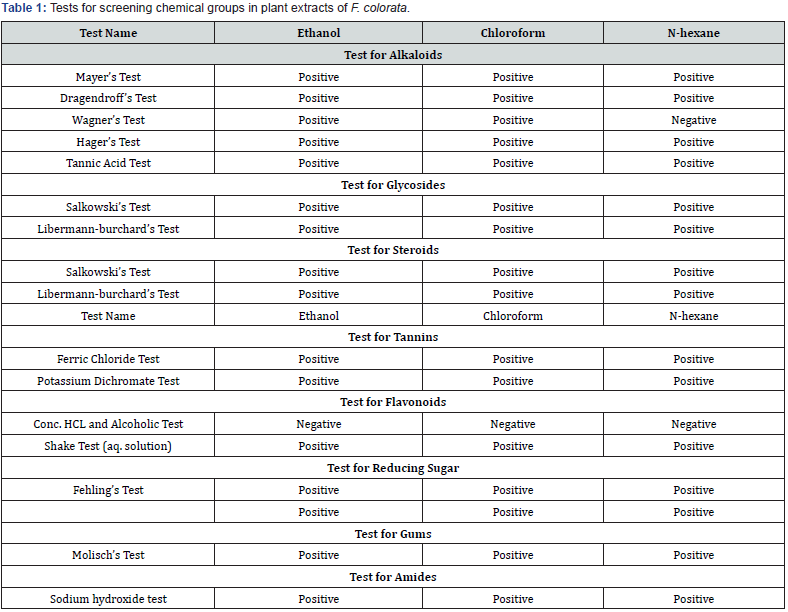
i. Presumed chemical groups for the plant F. colorata
The following compositions were identified in Table 2.

i. Presumed chemical groups for the plant F. colorata
The following compositions were identified in Table 2.
Results and Discussion
Screening for Anti-atherothrombosis Activity
Preparation of Test Samples, Standard and Control Groups
i. Double distilled water (DDW) and Streptokinase were taken as negative and positive controls respectively.
ii. Each extract of ethanol, n-hexane and chloroform (500μg) of F. colorata. For this purpose, 10mg crude extract was dissolved in 2 ml respective solvents.
Experiments for clot lysis were carried as reported earlier. In brief, 4 ml venous blood drawn from healthy volunteers and was distributed in five different (3 for extracts, 1 for reference standard and 1for negative control) pre-weighed sterile micro centrifuge tubes (0.5 ml/tube) and incubated at 37ºC for 45 min. After clot formation, serum was completely removed without disturbing the clot and each tube having clot was again weighed to determine the clot weight. 100 μl of ethanol, n-haxane and chloroform extracts of F. colorata was added to the respective micro-centrifuge tube containing pre-weighed clot. As positive controls, 100 μl of Streptokinase and as a negative control 100 μl of DDW were separately added to the control numbered. All the tubes were then incubated at 37ºC for 90 min and observed for clot lysis. After incubation, fluid released was removed and tubes were again weighed to observe the differences in weight after clot disruption. Difference obtained in weight taken before and after clot lysis was expressed as percentage of the clot lysis. The experiment was duplicated at the different days with the blood samples of 5 healthy volunteers. Blood collection, incubated at 37ºC, weight of alpine tubes with blood, 0.5 ml in each tube and taken serum by cotton (Table 3).
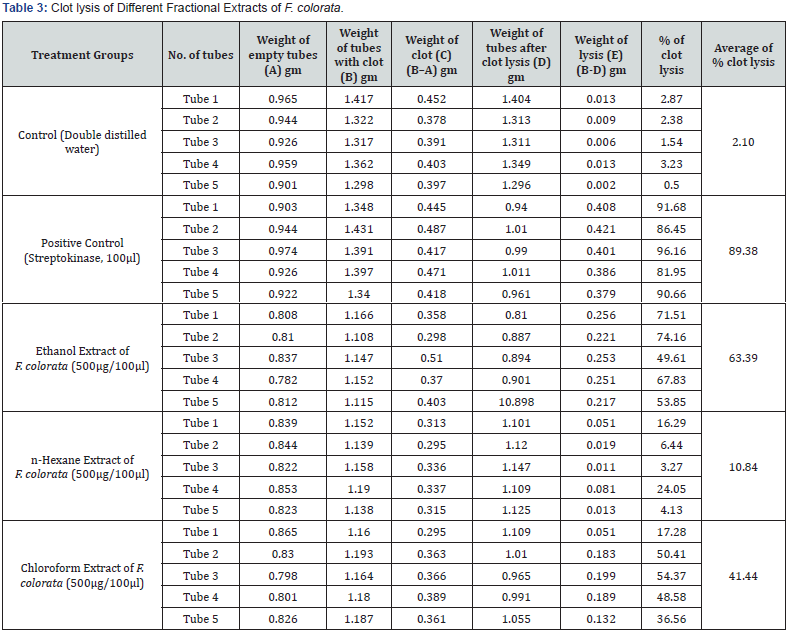
The results obtained from analgesic activity test were expressed as the mean ± SEM. The results were analyzed using one-way ANOVA followed by using Dunnett’s t-test. The statistical analysis was carried out with SPSS software version 20 (Windows). A difference was considered significant at p<0.001. Screening of Anti-atherothrombosis evaluated by, 100μl from ethanol, chloroform and n-hexane extracts of leaves of F. colorata and 100μl (30,000 I.U.) of streptokinase and 100 μl distilled water were assed to the blood clots, incubated at 37o C for 90 minutes and the clot lysis was observed. Maximum clot lysis activity observed in clot treated with Streptokinase (SK) which was 89.38% extracts of F. colorata showed 63.39%, 41.44% and 10.84% respectively (Table 3). Distilled water as a negative control showed negligible clot which was only 2.10%. Statistical representation of the effective clot lysis percentage was significant (p<0.001) by the crude extracts, positive control (streptokinase) and control (DDW) (Table 4).
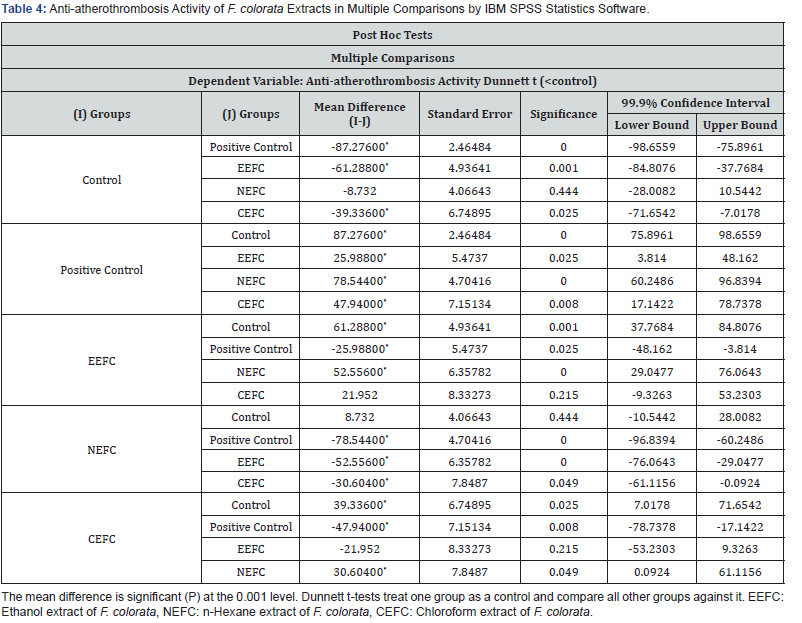
Screening for Analgesic Activity
Swiss-albino mice of either sex, average weight 25-30gm each were used for the experiment.
Preparation of Samples for The Test, Standard and Control Groups
i. For control group small amount of (1%) Tween-80 was mixed with distilled water and final volume was adjusted to make 10 ml.
ii. For positive control group, 3 mg/kg body weight of Loperamide was dissolved in control.
iii. For test sample, ethanol, chloroform and n-hexane extracts of F. colorata were dissolved respectively in control at the dose rate of 500 mg/kg body weight.
The animals were all screened initially by giving 0.4 ml of castor oil and only those showing diarrhea were selected for the final experiment. The animals were then, divided into control, positive control and two test groups containing three mice in each group. Control group received vehicle (1% Tween-80 in water) at a dose of 10 ml/kg body weight orally. The positive control group received Loperamide at the dose of 3 mg/kg orally; test groups received the ethanol extract, n-hexane extract and chloroform extract of F. colorata at the dose of 500 mg/kg body weight orally. Each animal was placed in an individual cage, the floor of which was lined with blotting paper. The floor lining was changed every hour. Diarrhea was induced by oral administration of 0.4 ml castor oil to each mouse, 30 minutes after the above treatments. During the observation period (4 hrs), the total latency periods (first diarrheal stool after the administration of castor oil) and the number of diarrheic feces excreted by the animals were recorded.).
Determination of Anti-diarrheal Activity
Anti-diarrheal episode was determined by evaluating the latency period and diarrheal frequency by counting the fecal time and number of the test groups in comparison to the control and standard drug Loperamide groups. In the castor oil induced diarrheal mice, the different extracts of the F. colorata at the doses of 500 mg/kg reduced the total number of stool in the mice to a considerable extent as well as increased the latency period respectively in comparison to the negative control groups and the result was statistically significant. The n-hexane, Chloroform and Ethanol extracts of F. colorata shows latency 35.66-minute, 37.66 minute and 41 minutes respectively in comparison with standard drug Loperamide (50.66 minute) as shown in Table 5. Among the three extracts, the Ethanol and Chloroform extract number of stool count as comparison with standard loperamide as shown in Table 6. Whereas the Ethanol and Chloroform extracts was showed any anti-diarrheal activity (p<0.05).
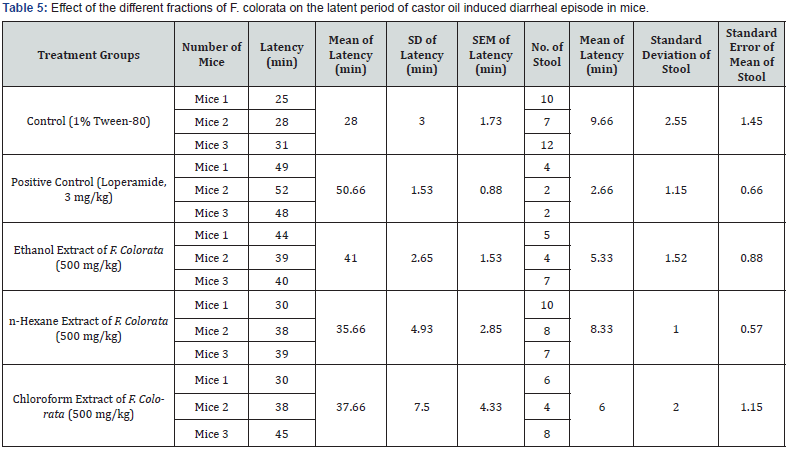

Screening for Analgesic Activity
Preparation of Test Samples
i. 20% Brewer’s Yeast solution: 20 mg of yeast was taken in a clean dried glass container and was dissolved in 100 ml distilled water and was stirred to the point to get a homogeneous suspension. The volume was made up to the mark of container so that a yeast suspension of 0.2 mg/ml is prepared.
ii. Aqueous solution of Paracetamol (150 mg/kg): 150 mg of paracetamol powder was taken in a volumetric flask and was dissolved in 10 ml distilled water and with continuous stirring an aqueous solution was prepared.
iii. Aqueous solution of Ethanolic, N-hexane and Chloroform extract of F. colorata (500 mg/kg): For this purpose, 500 mg crude extract was dissolved in 10 ml water and with continuous stirring an aqueous solution of different extracts were prepared.
Yeast Powder Inducted Anti-Pyretic Activity Test
Antipyretic activity of the crude extractives was measured by slightly modifying the method described by Adams et al., (1968). Swiss mice were fasted overnight with water ad libitum before the experiments. Pyrexia was induced by subcutaneously injecting 20% (w/v) brewer’s yeast suspension (10 ml/kg) into the animals’ dorsum region. Seventeen hours after the injection, the rectal temperature of each mouse was measured using a digital thermometer (SK- 1250MC, Sato Keiryoki Mfg. Co., Ltd., Japan). Only mice that showed an increase in temperature of at least 0.7 ˚F were used for the experiments. Test samples were administered orally, and the temperature was measured at 1, 2 and 3 hr after drug administration. Control group received distilled water only.
Result of Analgesic Screening
Screening for analgesic activity test the Ethanol, Chloroform and n-Hexane extract of F. colorata exhibited inhibition of writhing reflex by 53.15% (P<0.001), 53.94% (P<0.001) and 59.95% (P<0.001) respectively at the dose of 500mg/kg body wt. in comparison with the positive control Diclofenac at the same dose exhibited 67.75% inhibition of writhing reflex (P<0.001) as shown in Tables 7a & b. In the tail immersion test after 2 hours, the mean increase time(s) of immersed tail control group (1.33 s) and positive control group (7.33 s). But the different extractives of F. colorata at the dose of 500 mg/kg increased in latency, whereas ethanol (4.33 s), chloroform (4.33 s) and n-hexane (5.66 s) as shown in Table 7c.
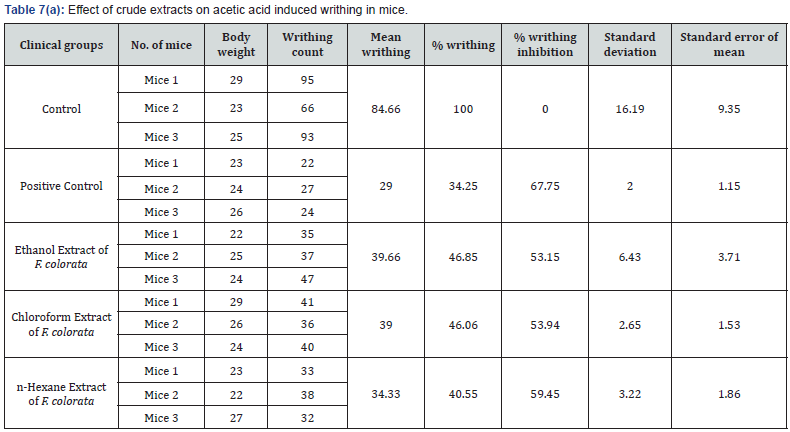
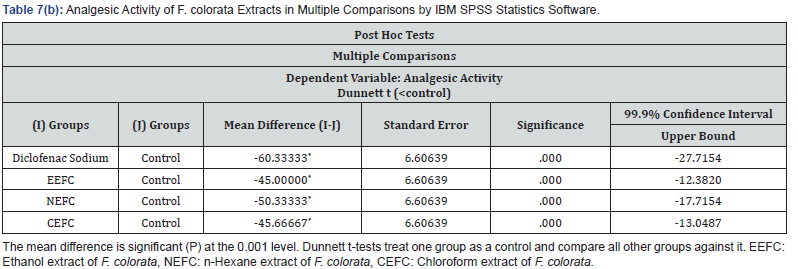

Screening for Analgesic Activity

The effect of Ethanol, n-Hexane & Chloroform extracts of F. colorata on mice is presented in Table 8. In this test, all the extracts at a dose of 500 mg/kg B.W significantly decrease pyrexia in mice up to 3 hours. Throughout the experiment, the EEFC, NEFC, CEFC extracts reduced temperature from 101.5°F to 100.4°F (p<0.05), 104.08°F to 99.2°F (p<0.05), 101.5°F to 101.3°F (p<0.05) respectively and produced a significant antipyretic activity in comparison with the positive control Paracetamol showed very significant antipyretic activity (p<0.05) starting after 1st hour of administration up to next 3 hours (Table 9). Young Swiss-albino mice of either sex, average weight 25-30 gm were used for the experiment. Taking 3 mice in each divided into five group control, positive control and three fractional extracts of F. colorata.

Preparation of Sample Tests, Standard and Control Groups
I. For test groups, 500mg/kg of leaves extracts of F. colorata (ethanol, n-hexane and chloroform) were selected. II. For standard (25 mg/kg), Diclofenac-Na (CLOFENAC, 50mg/Tab., Square Pharmaceuticals Ltd., Bangladesh) was taken and a suspension of 10 ml was made.
III. For control group, 1% of Tween-80 was added with double distilled water (DDW) to 10 ml. IV. For preparation of 0.9% acetic acid solution, 0.9 ml glacial acetic acid was mixed with DDW to 100 ml.
Experimental Design for Acetic Acid Induced Writhing Method
Experimental animals were randomly selected and divided into four groups denoted as control, positive control, and 500 mg/kg for each extract consisting of 3 mice in each group. Each mise was weighed properly, and the dose of the test samples and control materials were adjusted accordingly. Test samples, control and diclofenac-Na were given orally by means of a feeding needle. A thirty minutes interval was given to ensure proper absorption of the administered substances. Then the writhing inducing chemical, acetic acid solution (0.9%, 0.1 ml/ 10 gm) was administered intra-peritoneally to all. After an interval of five minutes, which was given for absorption of acetic acid, number of squirms (writhing) was counted for 30 min.
Screening for CNS Depressant Activity Experimental Animals
Swiss-albino mice of either sex, average weight 25-30gm each were used for the experiment. The animals were divided into 4 groups of 3 animals each.
Open Field Test
The Open Field Test was adopted for this test. The test was performed after slight modification of the previously proposed method. The aim of this study was to characterize the emotional behavior of mice using the square-cross test. The Swiss mice were grouped into four distinct groups with 3 mice in each namely - for extract dose (400 mg/kg), for standard (5 mg/kg) of diazepam was taken. Samples were administered orally to the mice. A 30 minutes interval was taken after drug administration then the numbers of square crossed by the mice were counted for 5 minutes. Then the samples data were compared with normal group for possible action of the extract.
Hole Cross Test
The Hole Cross Test was adopted for this test. The test was performed after slight modification of the previously proposed method. The aim of this study was to characterize the emotional behavior of mice using the hole-board test. The Swiss mice were grouped into four distinct groups with 3 mice in each namely - for extract, dose (400 mg/kg), vehicle (DDW) and normal (without sample) groups. Samples were administered orally to the mice. A 30 minutes interval was taken after drug administration then the numbers of hole crossed by the mice were counted for 5 minutes. Then the samples data were compared with normal group for possible action of the extract. During the open field test after 120 minutes, square crossed by the control (41) and positive control group (15). But at the 500 mg/kg dose, Ethanol (29) and Chloroform (28.66) extract significantly (p< 0.001) decreases the movement then n-Hexane extract (33) shown in figure 1. In the hole cross test after 120 minutes, the number of holes crossed by the control group (10.33) and positive control group (7.66). But the test samples of F. colorata at the dose of 400 mg/kg ethanol extract crossing movements of the experimental animals were almost similar to the control group (10.66). As well as chloroform (11.66) and n-hexane (12.33) extracts shows no activity in this method shown in figure 2.
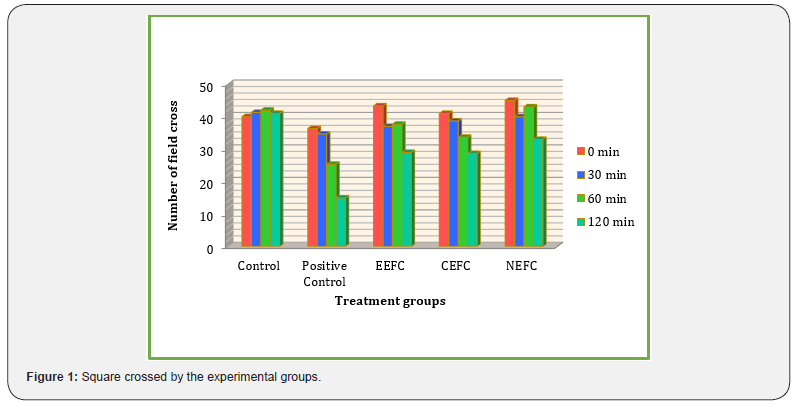

Conclusion
From the above screening and tabular presentation, it is observed that the ethanolic, chloroform and n-hexane extracts of F. colorata contains glycosides, steroids, alkaloids, saponins, reducing sugar, gums and amides. Clot lysis activity was evaluated by taking 100μl from ethanol, chloroform and n-hexane extracts of leaves of F. colorata and 100μl (30,000 I.U.) of streptokinase and 100 μl distilled water were assed to the blood clots, incubated at 37oC for 90 minutes and the clot lysis was observed. Maximum clot lysis activity observed in clot treated with Streptokinase (SK) which was 89.38% extracts of F. colorata showed 63.39%, 41.44% and 10.84% respectively. Distilled water as a negative control showed negligible clot which was only 2.10%. Statistical representation of the effective clot lysis percentage was significant (p<0.001) by the crude extracts, positive control (streptokinase) and control (DDW). In the castor oil induced diarrheal mice, the different extracts of the F. colorata at the doses of 500 mg/kg reduced the total number of stool in the mice to a considerable extent as well as increased the latency period respectively in comparison to the negative control groups and the result was statistically significant. The n-hexane, Chloroform and Ethanol extracts of F. colorata shows latency 35.66-minute, 37.66 minute and 41 minutes respectively in comparison with standard drug Loperamide (50.66 minute). Among the three extracts, the Ethanol and Chloroform extract number of stool count as comparison with standard loperamide. Whereas the Ethanol and Chloroform extracts was showed any anti-diarrheal activity (p<0.05). Antipyretic activity was evaluated by Brewer’s yeast injection method. Extractives of F. colorata at 500 mg/kg dose, significantly (P<0.05) showed antipyretic activities starting from 1st hr to 3rd hr after drug administration. The effect of Ethanol, n-Hexane & Chloroform extracts of F. colorata on mice is presented. In this test, all the extracts at a dose of 500 mg/kg B.W significantly decrease pyrexia in mice up to 3 hours. Throughout the experiment, the EEFC, NEFC, CEFC extracts reduced temperature from 101.5°F to 100.4°F (p<0.05), 104.08°F to 99.2°F (p<0.05), 101.5°F to 101.3°F (p<0.05) respectively and produced a significant antipyretic activity in comparison with the positive control Paracetamol showed very significant antipyretic activity (p<0.05) starting after 1st hour of administration up to next 3 hours. Crude extracts were evaluated to observe the activity of analgesic by Acetic acid induced writhing count method on albino mice. Screening for analgesic activity test the Ethanol, Chloroform and n-Hexane extract of F. colorata exhibited inhibition of writhing reflex by 53.15% (P<0.001), 53.94% (P<0.001) and 59.95% (P<0.001) respectively at the dose of 500mg/kg body wt. in comparison with the positive control Diclofenac at the same dose exhibited 67.75% inhibition of writhing reflex (P<0.001). In the tail immersion test after 2 hours, the mean increase time(s) of immersed tail control group (1.33 s) and positive control group (7.33 s). But the different extractives of F. colorata at the dose of 500 mg/kg increased in latency, whereas ethanol (4.33 s), chloroform (4.33 s) and n-hexane (5.66 s).
References
- Newman DJ, Cragg GM, Snader KM (2000) The influence of natural products upon drug discovery. Nat Prod Rep17(3):215-34.
- Jachack SM, Saklani A (2007) Challenges and opportunities in the drug discoveries from plant. Curr Sci4:1251-1257.
- Ghani A (1998) Medicinal Plants of Bangladesh. Asiatic Society of Bangladesh1: 236.
- Seyyednejad SM, Koochak H, Darabpour E, Motamedi H (2010) A survey on Hibiscus rosa-sinensis, Alcearosea L. and Malva neglectaWallr as antibacterial agents. Asian Pac J Trop Med 3(5): 351-355.
- Abat JK, Kumar S,Mohanty A (2017) Ethnomedicinal, Phytochemical and Ethnopharmacological Aspects of Four Medicinal Plants of Malvaceae Used in Indian Traditional Medicines: A Review. Medicines (Basel)4(4).
- Scartezzini P,Speroni E (2000) Review on some plants of Indian traditional medicine with antioxidant activity. Journal of ethnopharmacology 71(1-2): 23-43.
- Ali BH, WabelNA,BlundenG(2005) Phytochemical, pharmacological and toxicological aspects of Hibiscus sabdariffa L.: a review. Phytother Res 19(5): 369-375.
- El-Sherei MM, Ragheb AY, KassemMES, MarzoukMM, MosharrafaSA, et al.(2016) Phytochemistry, biological activities and economical uses of the genus Sterculia and the related genera: A reveiw. Asian Pac J Trop Dis 6(6): 492-501.
- Viles-Gonzalez JF, Fuster V,Badimon JJ(2004) Atherothrombosis: a widespread disease with unpredictable and life-threatening consequences. Eur Heart J 25(14): 1197-1207.
- Azam MNK, AhmedMN, RahmanMM, Rahmatullah M (2013) Ethnomedicines used by the Oraon and Gor tribes of Sylhet district, Bangladesh. Am-Eur J Sustain Agr 7: 391-402.
- Khaki A, Fathiazad F (2012) Diabetic Nephropathy – Using Herbals in Diabetic Nephropathy Prevention and Treatment – The Role of Ginger (Zingiber officinale) and Onion (Allium cepa) in Diabetics’ Nephropathy. Bhattacharya (Ed.), A Compendium of Essays on Alternative Therapy, Intech Open London, UK pp. 302.
- Costa DAD, CavalcantiAC, MedeirosMAAD, Lima JTD, Cavalcante JMS(2007) Chemical constituents from Bakeridesiapickelii Monteiro (Malvaceae) and the relaxant activity of kaempferol-3-O-beta-D-(6"-Ep-coumaroyl) glucopyranoside on guinea-pig ileum. Quimica Nova30(4).






























